Mackerel, sardines or salmon? Top tinned fish for omega-3s

Tinned fish is a convenient source of protein that can boost your diet at a fraction of the cost of poultry, meat and fresh fish.
Some varieties are also packed with omega-3 essential fatty acids (EFAs), which we know to be vital for lowering ‘bad’ cholesterol and supporting brain health.
But how do you know what type of tinned fish to choose for the best? We painstakingly picked our way through more than 90 products* to find those with the highest omega-3 levels, and uncovered benefits - and some of the pitfalls along the way.
Eat well, live better, stay healthy: sign up for our free health newsletter for the latest insights delivered straight to your inbox
How we picked the top tinned fish for omega-3s
Analysed 90+ tinned fish varieties
We examined tinned fish from high-end brands to budget supermarket options, assessing their nutrient content, including protein, saturated fat, salt and sugar.
What's highest in omega-3 essential fats?
We found a broad range, including a product that was around six times higher than the lowest scrutinised.
Saltiest, sweetest, priciest, cheapest: how they ranked
We compared them all to discover those that stood out for being lowest or highest in price, or had the most sugar or salt.
Reviewed by our Which? nutritionist
Shefalee Loth is a public health nutritionist with 20 years' experience, and has worked for the NHS, The London School of Hygiene & Tropical Medicine and the World Cancer Research Fund.
Tinned fish: health benefits and recommended intake
Tinned oily fish contains high-quality protein, vitamins (including D and B12), calcium (from the edible bones of some canned varieties), and is a rich source of omega-3 essential fatty acids (EFAs).
Omega-3 EFAs are a family of polyunsaturated fatty acids comprising three types, including the two in oily fish - EPA and DHA. The other, ALA, is found in plant foods such as flaxseed.
EPA and DHA are important for heart, lung, blood vessel health, hormone and immune system health. Neither can be made by the body so you need them in your diet.
Recommended intake of oily fish
The Food Standards Agency (FSA) recommends that most people eat two portions of fish per week, with a portion size of around 140g (cooked weight), and one of these portions should be oily fish, as they contain beneficial long-chain omega-3 fatty acids.
If you’re a man or an older woman, you’re actually allowed up to four 140g portions of oily fish per week. Still, younger, pregnant and breastfeeding women shouldn't have more than two oily fish portions a week because fat-soluble contaminants found in them, like dioxins and PCBs, may impact a developing foetus.
There’s no UK government recommendation for omega-3s, but a single weekly oily fish portion will give you the equivalent of around 450mg of combined EPA and DHA per day. However, research shows that much of the UK population consumes less than 50mg of omega-3 fatty acids per day, and only 16-17% meet the weekly oily fish recommendation.
Can you eat too much tinned fish?
A concern when eating fish may be mercury because fish consume plankton that produce methylmercury. However, scientific testing reveals that, due to their short lifespan and low position in the food chain, small oily fish such as sardines, mackerel, pilchards, and even salmon are very low in mercury.
Higher levels are found in swordfish, shark and fresh tuna, which is why the FSA suggests limiting consumption. Although mercury levels in canned tuna are lower because 'skipjacks' are younger, smaller fish, pregnant women should limit their consumption to no more than four cans per week.
Do popular diets really work? Our nutrition expert assesses the evidence behind popular weight loss plans such as keto, paleo and Slimming World
Which tinned fish type is the healthiest?
Starting with the most abundant, mackerel, sardines, and salmon officially have the highest levels of omega-3s of all the tinned fish. While our market analysis of more than 90 products reflected this general pattern, there was a wide variation within each fish type and from one brand and recipe to the next.
For example, Princes skinless boneless wild red salmon has 900mg of omega-3 per 100g compared to Sainsbury’s skinless boneless wild Pacific red salmon, which has almost double that at 1,600mg per 100g.
Kippers, skippers, brisling, sild and sprats (all types of herring) plus pilchards (older, larger sardines) are other good choices for omega-3 you can find in the tinned fish aisle.
Tinned anchovies are also classified as oily fish, but are often high in salt, so use them sparingly.
Tinned crab contains omega-3s; the amounts are low, so it doesn’t count as one of your oily fish portions.
As for tinned tuna, being cooked before canning drastically reduces omega-3 levels, although some are still present, but not at the levels found in other tins tested.
Mackerel vs sardines vs salmon: how omega-3s compare
Top 3 tinned fish products:
Mackerel
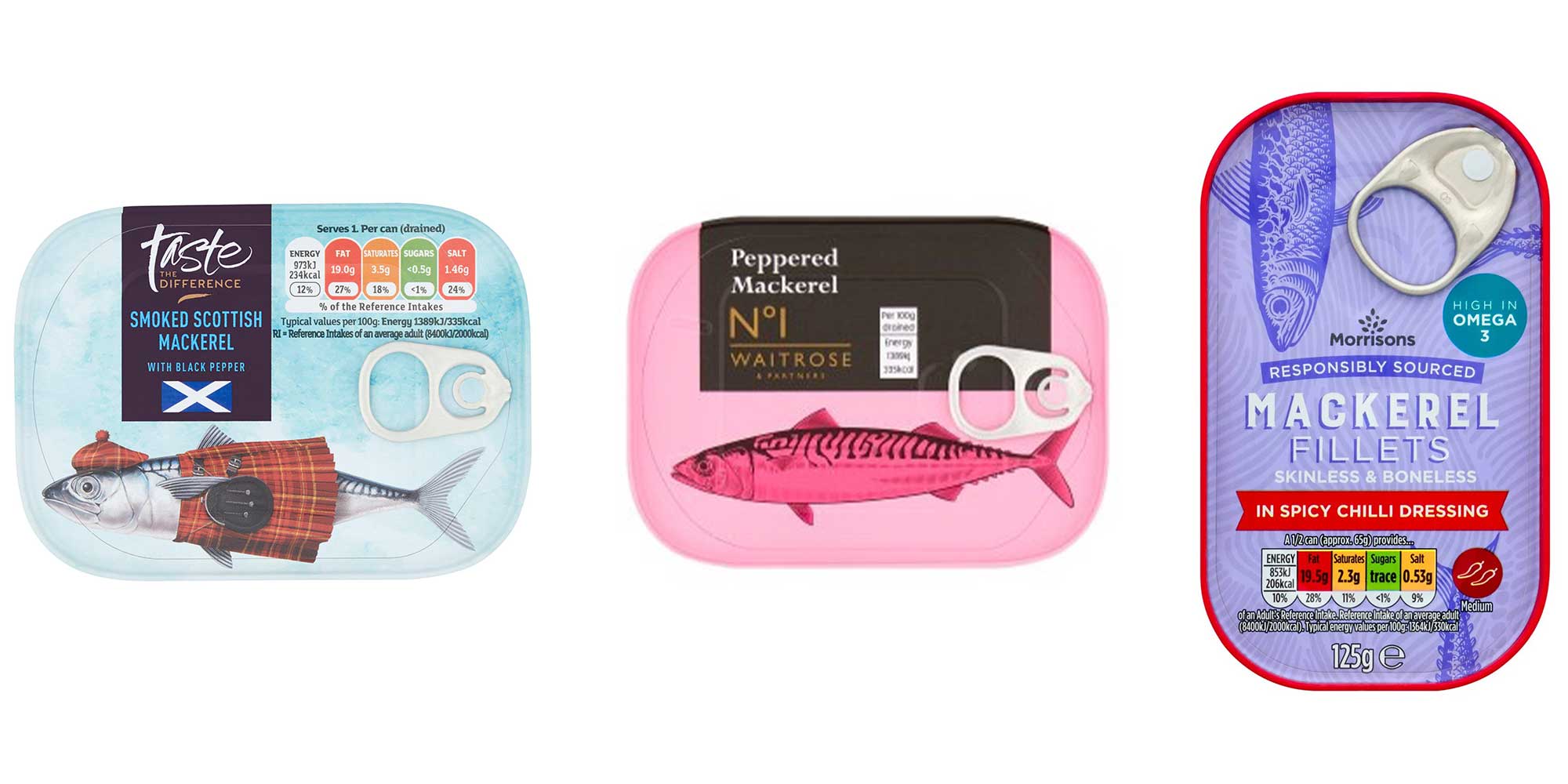
- Sainsbury’s Taste The Difference smoked Scottish mackerel with black pepper, 4,700mg omega-3 per 100g (£2.30 for 110g tin, Sainsbury's)
- Waitrose No.1 peppered mackerel, 4,340mg omega-3 per 100g (£2.30 for 110g tin, Waitrose)
- Morrisons mackerel in spicy chilli, 3,900mg omega-3 per 100g (£1 for 125g tin, Morrisons)
Others that weren't far behind include Tesco Finest smoked peppered mackerel, 3640mg omega-3 per 100g (£3 for 110g tin, Tesco)
The tinned mackerel product with the lowest levels that we looked at was Princes spicy tomato jack mackerel fillets, containing 700g omega-3 per 100g - just over seven times less than the most abundant mackerel product.
Note: The Waitrose No.1 peppered mackerel also has the highest salt content that we found, so bear this in mind if you're watching your sodium levels.
Sardines
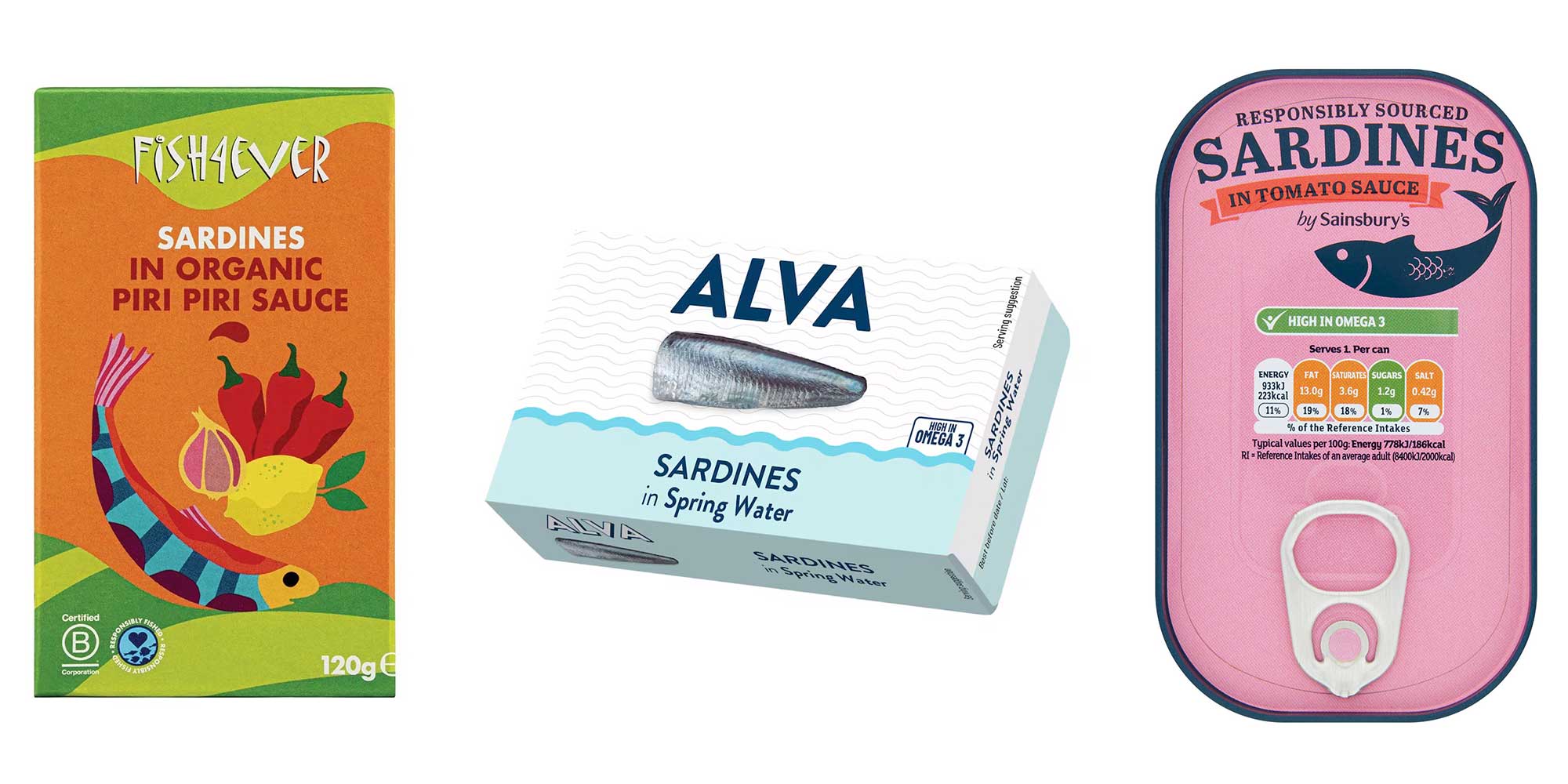
- Fish4ever sardines in organic piri piri sauce, 4,200mg per 100g (£3.35 for 120g tin, Ocado)
- Alva sardines in spring water, 3,570mg omega-3 per 100g (75p for 120g tin, Tesco). Same values for the brine product.
- Sainsbury’s sardines in tomato sauce, 3,100mg omega-3 per 100g (60p for 120g tin, Sainsbury's); Delicious sardines in olive oil, 3,100mg per 100g (£3.42 per 100g, Ocado)
The tinned sardine product with the lowest omega-3 levels we looked at was Alva sardines in tomato sauce, which had 940mg omega-3 per 100g - just under 4.5 times less than the most abundant sardine product.
Salmon
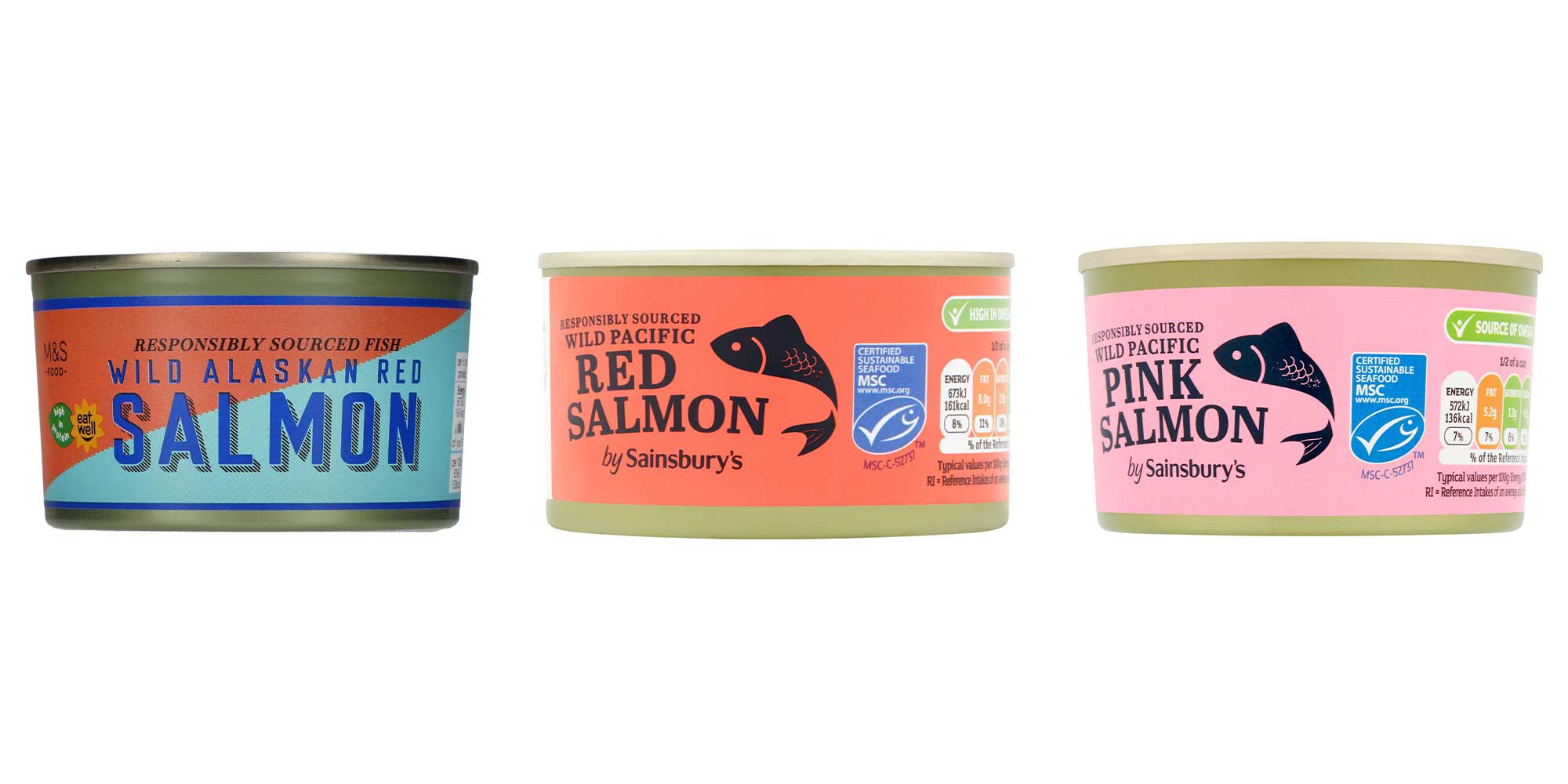
- M&S wild Alaskan red salmon, 2,000mg omega-3 per 100g (£3.65 for 213g tin, Ocado)
- Sainsbury's wild pacific red salmon, 2,000mg omega-3 per 100g (£3.50 for 212g tin, Sainsbury's)
- Sainsbury’s wild pacific pink salmon,1,900mg omega-3 per 100g (£2 for 212g tin, Sainsbury's)
The tinned salmon with the lowest omega-3 levels that we looked at was Waitrose boneless wild red salmon, which had 444mg omega-3s per 100g - almost five times less than the most abundant salmon product.
How to buy sustainable fish - the sustainability issues with some of our favourite fish, plus better alternatives and the labels to look for
Saltiest, sweetest and priciest tinned fish - our findings
We also scrutinised the salt and sugar levels of the 90+ tinned fish products, as well as how much they cost - here are some highlights:
| Category | Product name | Value (per 100g) | Price |
|---|---|---|---|
| Most salty | Waitrose No.1 peppered mackerel | 2.21g of salt | £2.30 for 110g tin (Waitrose) |
| Least salty | Fish4ever Scottish mackerel in spring water | 0.1g of salt | £2.95 for 125g tin (Ocado) |
| Most sugary | John West skinless and boneless mackerel fillets in smokehouse bbq sauce | 12g of sugar | £1.95 for 115g tin (Ocado) |
| Least sugary | 31 products, including Waitrose wild Pacific red salmon | 0g of sugar | £2.90 for 105g tin (Waitrose) |
| Most expensive | Ortiz sardines in olive oil | £6.75 for 140g tin (Ocado) | |
| Least expensive | Lidl Nixe sardines in sunflower oil | 47p for 120g tin (Lidl) |
When it comes to salt, adults should have no more than 6g (1 level tsp) daily, including salt that’s already in food as well as that added during and after cooking.
The saltiest tinned fish we found - Waitrose No.1 peppered mackerel - has 2.21g of salt per 100g - 22 times more than the least salty product - and a recommended 70g serving contains 1.55g of salt - that would be a quarter of your daily maximum.
In total, just five of the 90 products we examined contained 0.3g of salt or less per 100g, which is the official threshold for a food to get a green traffic light for salt.
When it came to sugar, the tinned fish with the most had 12g per 100g, while the vast majority were in the low-sugar range (5g or less per 100g), with around one-third containing no sugar.
However, although 12g tops the list for the most sugar, this amount is still considered 'moderate' for sugar (high would be more than 22.5g per 100g). Some products get it from natural sugars (eg those that contain tomato paste) while others have added sugar such as demerara.
Is there such a thing as a healthier sugar? Our Which? nutritionist weighs in to see how sugar stacks up against alternatives such as honey, agave and sweeteners
What's best: tinned fish, fresh fish - or omega-3 supplements?
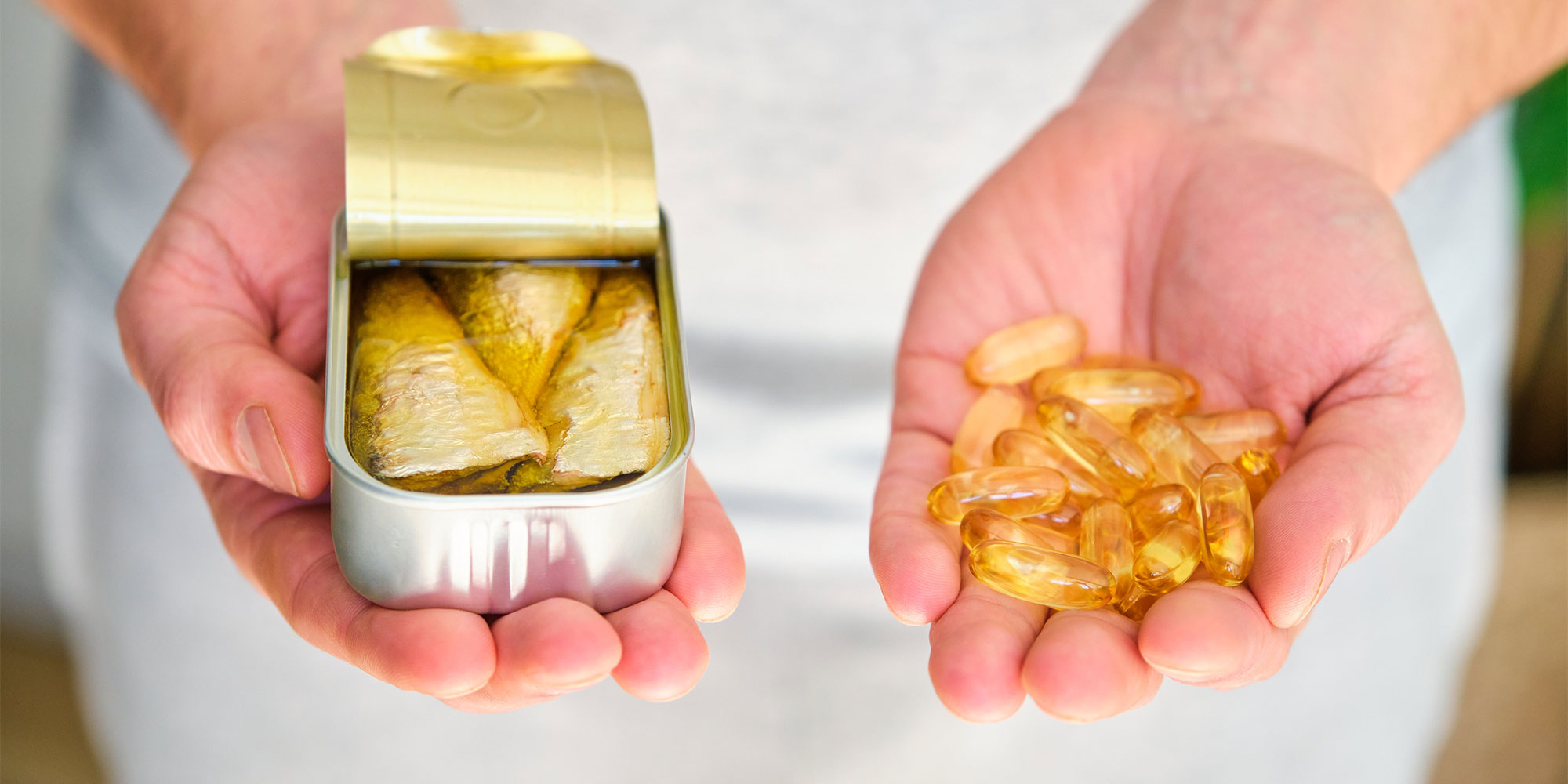
Neither tinned nor fresh fish is intrinsically ‘better’ - both have advantages and disadvantages relating to factors such as cost, shelf life, sustainability and nutritional content.
Tinned fish tends to be a cheaper, easier to store and a more sustainable choice, plus natural omega-3 oils are preserved by the canning process.
Fresh fish is expensive, but you’re paying for its flavour, texture, and a product without any added ingredients or processing. Ultimately, it comes down to personal preference.
A 2024 large-scale UK analysis found that fish oil supplements can be effective at boosting blood omega-3 levels, which may be music to the ears of those who struggle with their fish intake.
However, omega-3 supplements aren’t recommended in the general population because evidence of benefits is inconclusive. They are also contraindicated in some people, including those on blood thinners such as warfarin, plus they can be high in vitamin A, which can be toxic in large amounts. Speak to your doctor if you’re unsure.
Our nutrition experts have analysed popular vitamin D supplements, here are the ones we highly rated: Best vitamin D supplements to try now
Tips on choosing tinned fish
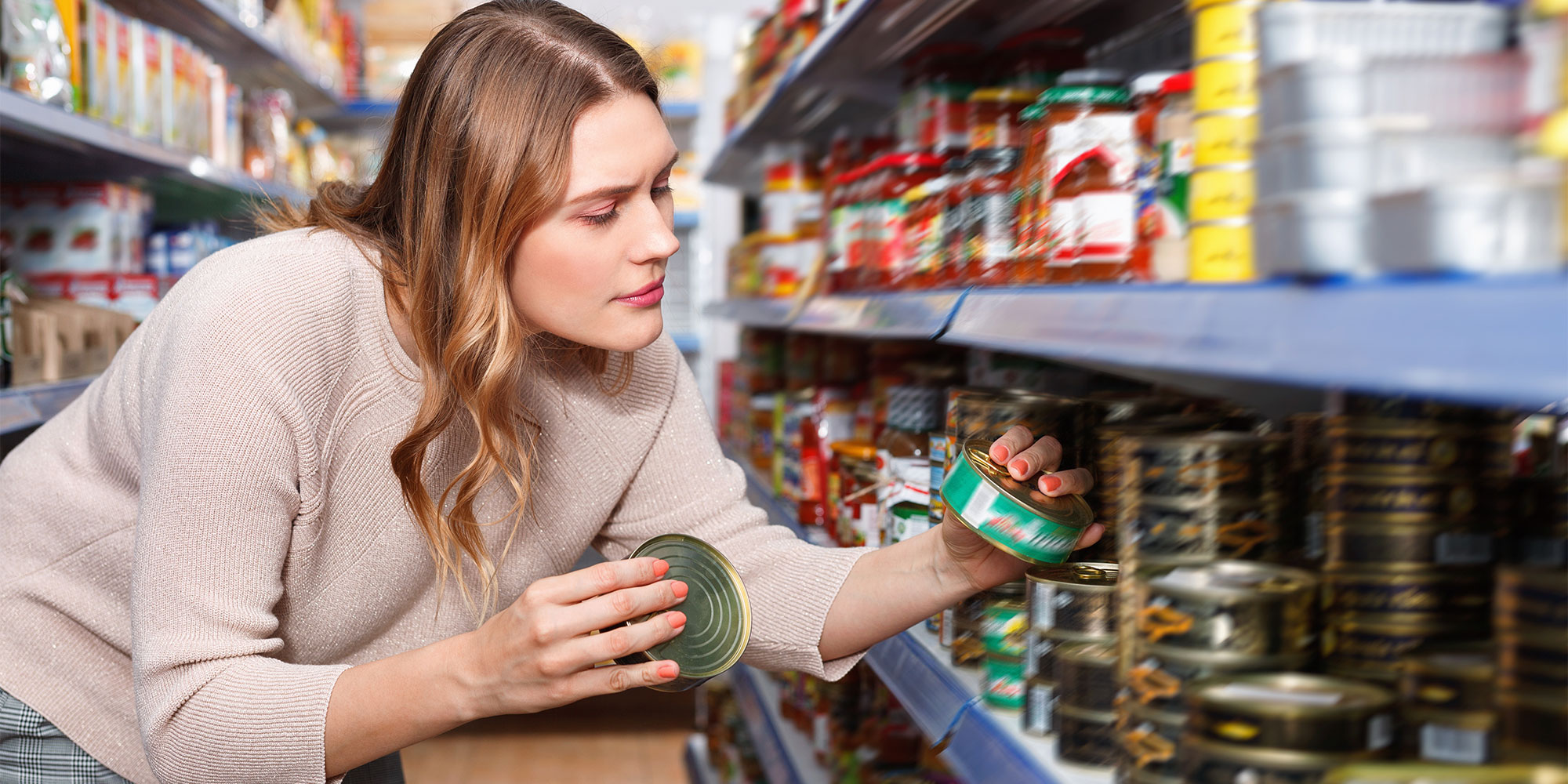
Fish in brine doesn't always have the highest salt levels. Intuition might tell you that fish in salt water will be highest in salt, but we found that some of the highest levels in flavoured sauce varieties. For example, Morrisons mackerel fillets in brine have 0.77g of salt per 100g while Morrisons mackerel fillets in smokey BBQ sauce contain 1.52g salt per 100g.
Choose tomato sauce rather than ‘spicy’ tomato sauce. Fish varieties in plain tomato sauce, in the main, have natural sugars in them, but we found that those in ‘spicy’ tomato sauce had added sugar - in some cases more than double the amount. For example, Tesco mackerel in tomato sauce has 2g of sugar per 100g compared to Tesco mackerel in spicy tomato sauce, which has 4.8g.
Don’t worry if you can’t find omega-3 levels on packaging. It's not a legal requirement to declare omega-3s in the UK and EU, unless a specific health claim is made (eg 'High in omega-3'). However, stick with tinned mackerel, sardines, or salmon, and you can rest assured that you'll be getting omega-3 essential fats.
Six things we've learned about tinned fish
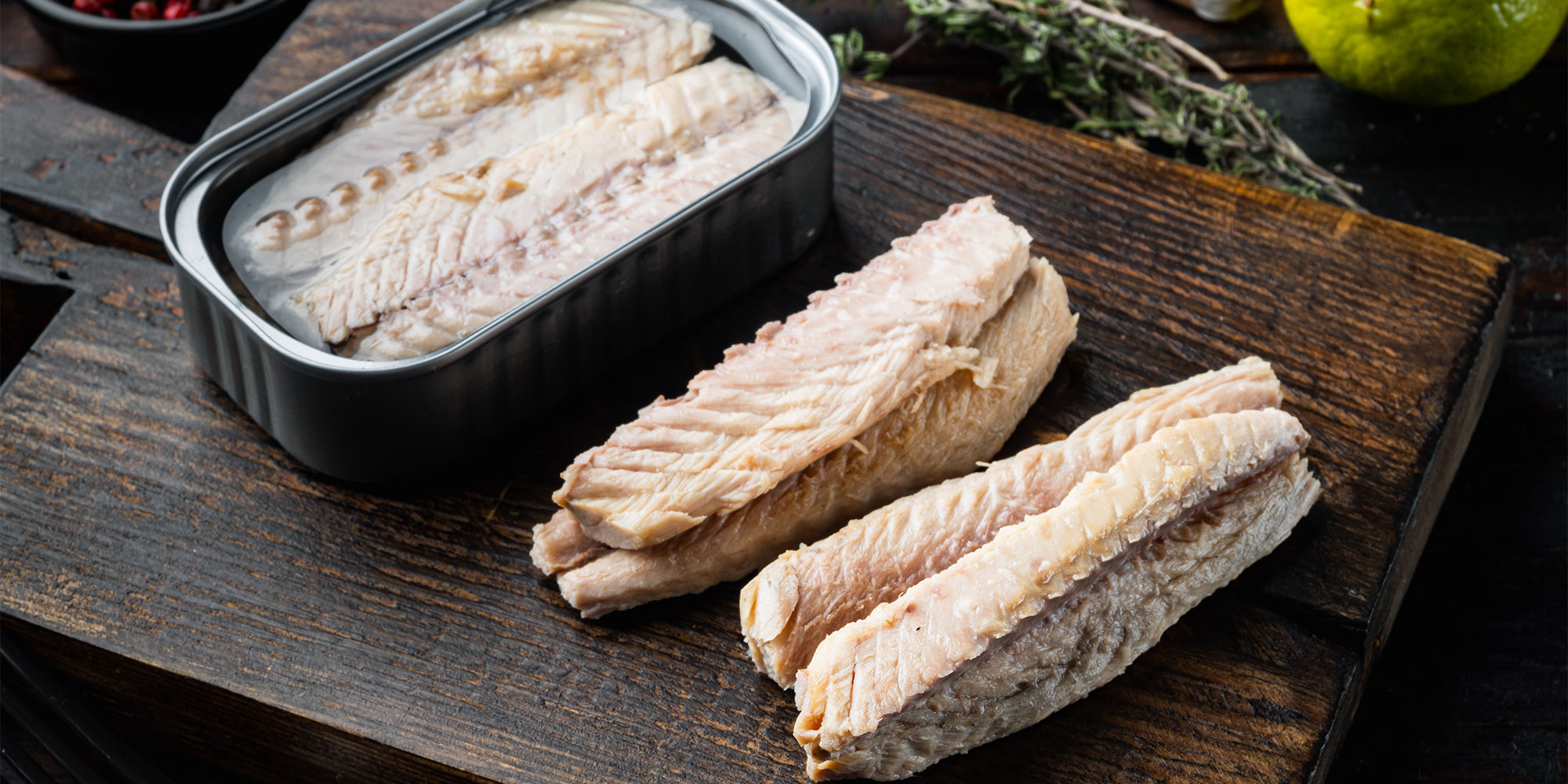
- Choose varieties in water or spring water for a healthy option. They'll be lower in salt than those in brine or a sauce, and lower in calories than those in oil.
- Keep tinned fish in your store cupboard. It’s a great staple that can last for several years and is a cheap and convenient protein source.
- Watching salt intake? Look for less than 0.3g per 100g on the pack info. In general, tinned fish in water or spring water is lowest in salt, and smoked or sauced varieties are highest.
- Eat the bones for calcium. Choose products with bones rather than ‘boneless’. Tinned sardines, pilchards and salmon tend to be calcium-rich from bones softened by the canning process.
- Add your own spices. If you’re after flavour and want to minimise your salt or sugar intake, choose a basic product in spring water or oil and add your own herbs and spices such as chilli.
- Make your own smoked mackerel pâté. Try a tin of peppered mackerel fillets (Tesco Finest hot smoked peppered mackerel fillets, £3 for 110g tin, Tesco) blended with a 300g tub of fat-free or low-fat cottage cheese. It makes a great dip or baked potato topping.
* Prices and nutritional details based on 93 tinned fish product nutritional details found both online and/or on packaging in store as of 12 November 2025. Nutrient levels may vary, so always check the pack details.




